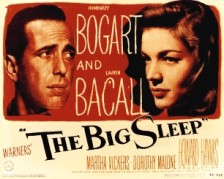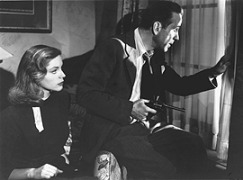|
The Big Sleep
|
| |
 |
USA, 1946. Rated "Approved."
114 minutes.
Cast:
Humphrey Bogart, Lauren Bacall, John Ridgely, Martha Vickers, Dorothy
Malone, Peggy Knudsen, Regis Toomey, Charles Waldron, Charles D. Brown,
Bob Steele, Elisha Cooke Jr, Louis Jean Heydt
Writers: Willaim Faulkner, Leigh Brackett & Jules Furthman, based
on the novel by Raymond Chandler
Music: Max Steiner
Cinematographer: Sid Hickox
Producers: Howard Hawks
Director: Howard Hawks
LINKS
|
 henever
someone says, "They sure don't make movies like they used to," I'm instantly
skeptical. I'm skeptical whether that person realizes that the history of cinema,
like human memory, is selective--only the good films are remembered, and the
crap is forgotten, as if it never existed. (In some cases, the films literally
don't exist anymore.) I'm skeptical whether that person fully appreciates the
advances in technology and storytelling techniques that have occurred over the
decades. I'm skeptical whether that person even bothers to seek out contemporary
movies, many of which will one day also be remembered as classics. Not The
Scorpion King or Kate & Leopold, to be sure, but perhaps In
the Bedroom and The Others, among
many meritorious candidates.
henever
someone says, "They sure don't make movies like they used to," I'm instantly
skeptical. I'm skeptical whether that person realizes that the history of cinema,
like human memory, is selective--only the good films are remembered, and the
crap is forgotten, as if it never existed. (In some cases, the films literally
don't exist anymore.) I'm skeptical whether that person fully appreciates the
advances in technology and storytelling techniques that have occurred over the
decades. I'm skeptical whether that person even bothers to seek out contemporary
movies, many of which will one day also be remembered as classics. Not The
Scorpion King or Kate & Leopold, to be sure, but perhaps In
the Bedroom and The Others, among
many meritorious candidates.
I'm skeptical of cinematic nostalgia, believing its basic assumptions to be
false. When I approach a time-weathered classic like The Big Sleep, my
expectations are no higher than they are going into movies today. After seeing
it, however, I have come to the following conclusion: they sure don't make movies
like they used to.
Featuring a notoriously convoluted plot that makes L.A.
Confidential seem uncomplicated, The Big Sleep is the second
screen outing of Bogart and Bacall, one of the best-remembered movie (and real-life)
couples of all time. They debuted in 1944 in To Have and Have Not, also
directed by Howard Hawks.
Bacall is captivating. Her insouciant insolence in this film is part of why
she became a superstar. It's a perfect match for Bogart's brash witticisms and
self-deprecating humor. The one-liners come fast and furious, just as they would
in a Hawks comedy. Bogart and Bacall are so good together that the story's impenetrability
doesn't matter much, as long as it keeps serving up suspenseful situations and
sassy dialogue. There's a reason the leads' names are larger than the film's
title on the DVD case.
The Big Sleep opens as private eye Philip Marlowe (Bogart) arrives at
the mansion of old, wheelchair-bound General Sternwood (Charles Waldron). He
first bumps into the General's rebellious younger daughter, Carmen (Martha Vickers),
who tries to sit in Marlowe's lap while he's standing up, as Marlowe later puts
it. Women are throwing themselves at Marlowe constantly in The Big Sleep,
including Dorothy Malone as a bookshop owner in a memorably flirtatious early
scene. Bogart is, frankly, an ugly little man (Bacall: "You're not very tall,
are you?" Bogart: "Well, I…uh, I try to be"), but there's an unmistakably magnetic
quality about him. Plus, remember that this is based on a Raymond Chandler pulp
novel (his first). Women are supposed to throw themselves at the hero.
The General hires Marlowe to make a blackmailer go away, but the assignment
turns out to be more thorny than it seems. Marlowe's predecessor in the General's
employ has disappeared. The tough, shrewd older daughter Vivian (Bacall) takes
a suspiciously avid interest in Marlowe's activities, trying to pin down out
exactly what he was hired to do. Then, there's a murder. And another. And another.
And another.
It seems one, or both, of the daughters may be mixed up in the killings, and
it becomes increasingly difficult for Marlowe to clean up after them. Everything
seems to keep coming back to a mysterious house owned by one Eddie Mars (John
Ridgely, who holds his own in the verbal swordplay). A famous anecdote underscores
just how complicated the plot is. Hawks reportedly contacted Chandler during
shooting because he wasn't sure who had killed the Sternwood family chauffeur,
or whether he had committed suicide. Apparently, Chandler had no idea.
Billed as a noir, The Big Sleep is not really, at least not in
the purest form. It certainly has noir elements--a femme fatale (or two)
and danger pressing in from all sides. The banter is too bright and humorous,
though. For a noir antihero, Marlowe is a little too sharp and almost
always one step ahead of the bad guys. He's the classic pulp detective, the
kind of character that cannot be used in the movies anymore because he has become
too much of a cliché. The way the screenwriters write him and Bogart plays him,
however, is no cliché, not even today. Both he and Bacall are unique cinematic
personages. There will never be another couple like them.
The DVD extras are a treasure trove for cinema buffs. Though The Big Sleep
was shot mostly in 1944, it was not released until 1946, remaining on the shelf
in favor of war movies, which the studios were desperately trying to release
before the imminent end of World War Two. The DVD edition includes the original
1944 version, which is twenty minutes longer and a little less sexually suggestive.
After Bacall's second movie, Confidential Agent (shot after The Big
Sleep), was released to poor reviews in 1945, her rising star seemed suddenly
tarnished. A full year after The Big Sleep wrapped, the studio and Hawks
shot several new scenes and reshot old ones to add more of the risqué dialogue
that had been so popular in To Have and Have Not, including the Bogart
and Bacall scene in the bar and the suggestive conversation about horses and
saddles. Other scenes were entirely cut out.
In the earlier version, the plot is more straightforward, but there's not as
much Bogart and Bacall. In the later version, the story becomes nearly impossible
to follow, but the film is is unquestionably more entertaining. A comparison
of the two versions is interesting not just for shedding light on how a classic
of the cinema evolved, but also for showing how a hot debutante (Bacall) can
be turned into a megastar with just a few dozen strokes of the pen and yards
of celluloid. Studios are constantly tinkering with films in post-production,
and even after the film is supposedly complete. Nowadays, last-minute alterations
are usually made in response to negative test screenings and often a sign of
the lowest common denominator sinking lower. It's rare that such tinkering leads
to a radical improvement of the film, like in The Big Sleep. Maybe studios
really did understand their audiences better back in the Golden Age of Hollywood.
Review
© April 2002 by AboutFilm.Com and the author.
Images © 2002 New Line Productions, Inc. All Rights Reserved.


